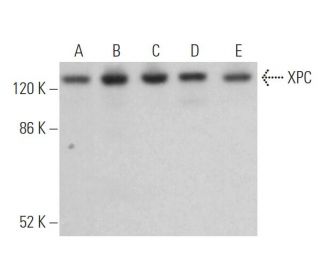
XPC Antikörper (D-10): sc-74410
- XPC Antikörper D-10 ist ein Maus monoklonales IgG2a κ XPC Antikörper, verwendet in 27 wissenschaftlichen Veröffentlichungen, in einer Menge von 200 µg/ml
- gegen Aminosäuren 641-940 kodiert, die an C-terminus von XPC von human Ursprung
- XPC Antikörper (D-10) ist empfohlen für die Detektion von XPC aus der Spezies mouse, rat und human per WB, IP, IF, IHC(P) und ELISA
- Anti-XPC Antikörper (D-10) ist erhältlich als Konjugat mit Agarose für IP; HRP für WB, IHC(P) und ELISA; und entweder mit Phycoerythrin oder FITC für IF, IHC(P) und FCM
- auch erhältlich als Konjugat mit Alexa Fluor® 488, Alexa Fluor® 546, Alexa Fluor® 594 oder Alexa Fluor® 647 für IF, IHC(P) und FCM
- auch erhältlich als Konjugat mit Alexa Fluor® 680 oder Alexa Fluor® 790 für WB (NIR), IF und FCM
- m-IgG Fc BP-HRP, 2a BP-HRP">m-IgG2a BP-HRP und m-IgGκ BP-HRP sind die bevorzugten sekundären Nachweisreagenzien für XPC Antikörper (D-10) für WB- und IHC(P)-Anwendungen. Diese Reagenzien werden jetzt in Bündeln mit XPC Antikörper (D-10) angeboten(siehe Bestellinformationen unten).
Direktverknüpfungen
Siehe auch...
Der XPC-Antikörper (D-10) ist ein monoklonaler IgG2a-Antikörper der leichten Kette Kappa der Maus, der das XPC-Protein von Mäusen, Ratten und Menschen durch Western Blot (WB), Immunopräzipitation (IP), Immunfluoreszenz (IF), Immunhistochemie mit in Paraffin eingebetteten Schnitten (IHCP) und Enzymimmunoassay (ELISA) nachweist. Der Anti-XPC-Antikörper (D-10) ist sowohl in nicht konjugierter als auch in verschiedenen konjugierten Formen erhältlich, darunter Agarose, Meerrettichperoxidase (HRP), Phycoerythrin (PE), Fluoresceinisothiocyanat (FITC) und mehrere Alexa Fluor®-Konjugate. Das XPC-Protein spielt eine entscheidende Rolle im Nukleotid-Exzisionsreparatur-Signalweg (NER), der die genomische Stabilität aufrechterhält, indem er umfangreiche DNA-Schäden, wie sie beispielsweise durch ultraviolettes Licht verursacht werden, erkennt und repariert. Mängel in diesem Reparaturmechanismus können schwerwiegende Folgen haben, darunter ein erhöhtes Hautkrebsrisiko, insbesondere bei Personen mit Xeroderma Pigmentosum (XP), einer genetischen Störung, die durch eine extreme Empfindlichkeit gegenüber Sonnenlicht gekennzeichnet ist. Das XPC-Gen, das sich auf Chromosom 3p25 befindet, kodiert ein Protein, das mit Cen2 und HR23B einen Komplex bildet, der für die Stabilisierung von XPC und die Erleichterung der Erkennung von DNA-Schäden von entscheidender Bedeutung ist. Der Carboxyterminus von XPC ist für die Bindung an HR23B und beschädigte DNA von entscheidender Bedeutung; Mutationen, die diese Region verkürzen, können zu nicht funktionsfähigen XPC-Proteinen führen, was die Bedeutung von XPC im DNA-Reparaturprozess weiter unterstreicht.
Alexa Fluor® ist ein Markenzeichen von Molecular Probes Inc., OR., USA
LI-COR® und Odyssey® sind Markenzeichen von LI-COR Biosciences
XPC Antikörper (D-10) Literaturhinweise:
- Das Centrosom-Protein Centrin 2/Caltractin 1 ist Teil des Komplexes der Xeroderma pigmentosum Gruppe C, der die globale Nukleotid-Exzisionsreparatur im Genom einleitet. | Araki, M., et al. 2001. J Biol Chem. 276: 18665-72. PMID: 11279143
- Komplementierung des DNA-Reparaturdefizits in menschlichen Zellen der Xeroderma pigmentosum Gruppe a und C durch rekombinanten Gentransfer mittels Adenovirus. | Muotri, AR., et al. 2002. Hum Gene Ther. 13: 1833-44. PMID: 12396616
- Die Carboxy-terminale Domäne des XPC-Proteins spielt durch Interaktionen mit dem Transkriptionsfaktor IIH eine entscheidende Rolle bei der Nukleotid-Exzisionsreparatur. | Uchida, A., et al. 2002. DNA Repair (Amst). 1: 449-61. PMID: 12509233
- Ein molekularer Mechanismus zur Erkennung von DNA-Schäden durch den Proteinkomplex der Xeroderma pigmentosum Gruppe C. | Sugasawa, K., et al. 2002. DNA Repair (Amst). 1: 95-107. PMID: 12509299
- Eine globale Genomreparatur ist erforderlich, um KIN17 zu aktivieren, ein auf UVC reagierendes Gen, das an der DNA-Replikation beteiligt ist. | Masson, C., et al. 2003. Proc Natl Acad Sci U S A. 100: 616-21. PMID: 12525703
- XPC über die Nukleotid-Exzisionsreparatur und Hautkrebs hinaus. | Zebian, A., et al. 2019. Mutat Res Rev Mutat Res. 782: 108286. PMID: 31843141
- XPC-Rollenvielfalt über die DNA-Schadensreparatur hinaus: p53-abhängige und p53-unabhängige Funktionen von XPC bei Entscheidungen über das Zellschicksal. | Zebian, A., et al. 2022. Mutat Res Rev Mutat Res. 789: 108400. PMID: 35690409
- XPC-PARP-Komplexe binden den Chromatin-Remodeler ALC1 ein, um die Reparatur von DNA-Schäden im gesamten Genom zu katalysieren. | Blessing, C., et al. 2022. Nat Commun. 13: 4762. PMID: 35963869
- Erkennung von Läsionen durch XPC, TFIIH und XPA bei der DNA-Exzisionsreparatur. | Kim, J., et al. 2023. Nature. 617: 170-175. PMID: 37076618
- Zuweisung des Gens für Xeroderma pigmentosum Gruppe C (XPC) zum Chromosom 3p25. | Legerski, RJ., et al. 1994. Genomics. 21: 266-9. PMID: 8088800
- Trennung der Proteinfaktoren, die die Defekte in den sieben Komplementationsgruppen der Xeroderma-Pigmentosum-Zellen korrigieren. | Tateishi, S., et al. 1995. J Biochem. 118: 819-24. PMID: 8576098
- Überproduktion, Reinigung und Charakterisierung der XPC-Untereinheit der menschlichen DNA-Reparatur-Exzisionsnuklease. | Reardon, JT., et al. 1996. J Biol Chem. 271: 19451-6. PMID: 8702634
Bestellinformation
| Produkt | Katalog # | EINHEIT | Preis | ANZAHL | Favoriten | |
XPC Antikörper (D-10) | sc-74410 | 200 µg/ml | RMB2377.00 | |||
XPC (D-10): m-IgG Fc BP-HRP Bundle | sc-528662 | 200 µg Ab; 10 µg BP | RMB2662.00 | |||
XPC (D-10): m-IgGκ BP-HRP Bundle | sc-521107 | 200 µg Ab, 40 µg BP | RMB2662.00 | |||
XPC (D-10): m-IgG2a BP-HRP Bundle | sc-547136 | 200 µg Ab; 10 µg BP | RMB2662.00 | |||
XPC Antikörper (D-10) AC | sc-74410 AC | 500 µg/ml, 25% agarose | RMB3129.00 | |||
XPC Antikörper (D-10) HRP | sc-74410 HRP | 200 µg/ml | RMB2377.00 | |||
XPC Antikörper (D-10) FITC | sc-74410 FITC | 200 µg/ml | RMB2482.00 | |||
XPC Antikörper (D-10) PE | sc-74410 PE | 200 µg/ml | RMB2580.00 | |||
XPC Antikörper (D-10) Alexa Fluor® 488 | sc-74410 AF488 | 200 µg/ml | RMB2685.00 | |||
XPC Antikörper (D-10) Alexa Fluor® 546 | sc-74410 AF546 | 200 µg/ml | RMB2685.00 | |||
XPC Antikörper (D-10) Alexa Fluor® 594 | sc-74410 AF594 | 200 µg/ml | RMB2685.00 | |||
XPC Antikörper (D-10) Alexa Fluor® 647 | sc-74410 AF647 | 200 µg/ml | RMB2685.00 | |||
XPC Antikörper (D-10) Alexa Fluor® 680 | sc-74410 AF680 | 200 µg/ml | RMB2685.00 | |||
XPC Antikörper (D-10) Alexa Fluor® 790 | sc-74410 AF790 | 200 µg/ml | RMB2685.00 |
